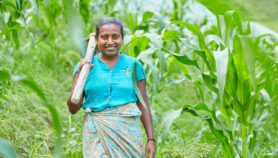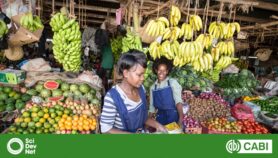By: Jim Kaput
Send to a friend
The details you provide on this page will not be used to send unsolicited email, and will not be sold to a 3rd party. See privacy policy.
Jim Kaput explains why efforts to tackle malnutrition should consider nutrigenomics — the interplay between food and genetic make-up.
Starving people do not just need food. They need the right nutrients to maintain and promote good health. Food aid can help prevent starvation but if it is not nutritionally balanced it could also contribute to chronic diseases and premature death.
Supplying key nutrients — through either whole foods, fortified foods or supplements — is especially important in developing countries, where malnutrition contributes to about 60 per cent of deaths among children under the age of five each year, according to Médecins Sans Frontières.
But what levels of nutrients are needed to maintain good health and prevent disease? To answer that, we must turn to nutrigenomics — the study of how nutrients interact with genes to alter metabolism.
Genetic variation
A person’s genes determine how their body absorbs and uses nutrients. Because each person is genetically unique, the amounts and types of nutrients needed to maintain good health may differ among individuals.
They can also differ between historically separated populations that have genetically adapted to cope with different local environments.
The most visible difference caused by this adaptation is skin colour. The variation from pink to brown not only helps to prevent sunburn but also allows appropriate amounts of sunlight to penetrate the skin to create the vitamin D3 from its inactive precursors.
A less obvious genetic adaptation is lactose persistence, which describes the continued production into adulthood of the enzyme lactase that metabolises lactose, the sugar found in milk. Most mammals stop producing lactase after weaning but those humans who could drink milk had access to protein, calcium and water, helping them survive the harsh climates of northern Europe and central Africa.
As a consequence, more of their descendents survived and bore the variant lactase gene. Many northern Europeans and central Africans retain the ability to drink milk, whereas about 70 per cent of the world’s population are lactose intolerant.
Differences in population genetics can also result from historical deficiencies or excesses of nutrients in soils, plants and animals. For example, the lack of iron, selenium or other micronutrients in the diet may have selected for genes that aid the uptake, storage and use of these essential nutrients.
Similar forces acted on domesticated plants and animals. For example, rice grown in the delta region of Arkansas is chemically and nutritionally different to rice grown in India because the local soils, rainfall, temperature and other conditions affect the plants’ growth, maturation and chemical make-up.
Getting the balance right
The main implication of this genetic variation in the developing world is that food alone is not enough. The wrong kind of food can be just as damaging to people’s health as a lack of food.
Consider, for example, the epidemic of obesity and chronic diseases that affects not only food-secure countries but also urban areas of developing countries, such as China, where one in six people (215 million individuals) are overweight, according to the WHO definition.
Excess calories and fat undoubtedly contribute to this epidemic but another factor is that many manufactured or processed foods are not nutritionally balanced. Industrialised nations are facing health and financial crises from this nutrient imbalance and developing countries must cope with the dual burdens of undernutrition in rural areas and overnutrition in urban centres.
Paradoxically, both forms of malnutrition may act through a similar molecular process of modifying DNA, called epigenetics, to cause stable, but non-heritable, changes to the way genes are used. Both undernutrition and overnutrition, particularly in the womb, can cause these epigenetic programs to create a mismatch between the ‘expected’ food environment and the actual one.
Supplying women of childbearing age and their children with sufficient calories is necessary but is not enough to optimise the epigenetic programming — the proper balance of micronutrients is essential for both short- and long-term health.
Of course, it is not enough to provide proper nutrition to young women — providing adequate nutrients to their children is also crucial for maintaining a food environment that promotes optimal health through adulthood. These well-established concepts need to inform public policy and food fortification programs.
Tailoring nutrition
Nutrigenomic science is still in its infancy and little is yet known about how to tailor nutrition interventions according to population genetics.
Progress has been slow because many studies have focused on local, relatively homogeneous populations using dissimilar experimental designs. But an international group of nutrigenomic scientists called the Micronutrient Genomics Projecthas started coordinating efforts to develop harmonised protocols and databases for comparing how individuals in different geographical and culturally distinct populations respond to food.
Such efforts are essential to provide food-policy experts and national and international agencies with the knowledge base for addressing malnutrition in the developing world.
The study of the interactions between genes and nutrients has begun but it requires significantly more investment in basic and applied research in genetically and culturally diverse populations. Such studies, if properly designed, can quickly convert the basic science into action to help alleviate nutrition insecurity.
Jim Kaput is director of the Division of Personalized Nutrition and Medicine at the US Food and Drug Administration (FDA).
The views expressed in this article do not reflect the official policy of the FDA.













